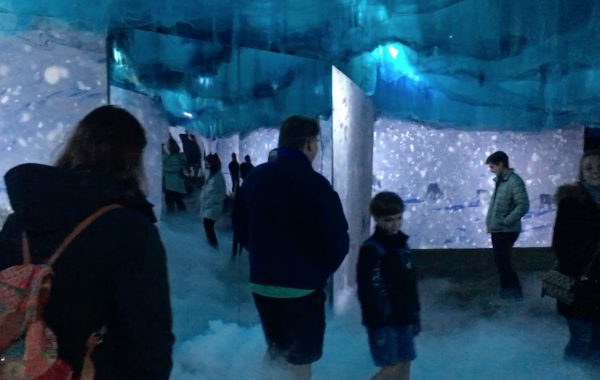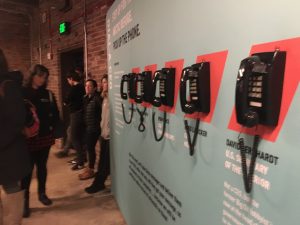
A multimedia exhibit about the Arctic popped up in a trendy warehouse district of Washington, D.C. last weekend. It aims to wow, not just with beautiful video, but scented fog and ethereal music. It’s a production designed to compel young people to care about the Arctic National Wildlife Refuge.
The show, called “The Arctic Refuge Experience,” sold out, at $10 a ticket. Outside a former meat market, next to a fashionable restaurant, hundreds lined up to get in.
“Checking in for two here? OK, just stand behind me,” said the greeter. “You can grab an iPad (and) sign a waiver.”
Visitors were warned that the show employed technology to play on their senses.
“This is a really serene, a peaceful, really lovely experience,” said one in a series of ushers and guides who built the suspense and set the mood. “We’d love to keep that vibe going, so please silence your phone.”
This is a new kind of outreach campaign by The Wilderness Society. For decades, national environmental groups made the fight to prevent oil drilling in the Arctic Refuge a top conservation issue for a wide swath of America. Now, with the government preparing for the first oil lease auction in ANWR, The Wilderness Society is trying to activate a new generation to keep up the fight, and a younger cohort requires a different kind of engagement. Exhibit ushers made it clear that visitors were to keep their phones silent but in hand.
“You’re going to want to take photos. You’re going to want to take video,” one guide said. “We’d love it, and if you share it on social, which we hope you do, please hashtag it #ProtectTheArctic because that’s what this is all about.”
First, we were taken to a small room for an introductory video. It features stylized caribou that glow like constellations.
“Beyond the Arctic Circle, there’s a thriving land,” says the narrator, Gwich’in Steering Committee leader Bernadette Demientieff of Fort Yukon. “It’s teeming with life, and one of the planet’s most majestic treasures. It has existed unspoiled and undeveloped for thousands of years. Can you picture of place like that?”
The screen shows snow, but what’s that sound in the background? Is that … crickets?

Yes, but never mind that now, because it’s time for the main show.
We move into a larger room that has half a dozen giant video screens, and equally large mirrors. The floor is spongy. There’s moss underfoot. The room smells faintly of Labrador tea, and white clouds billow in from an unseen fog machine. Gorgeous images fill the dark room. Ice. A melting river. Dramatic mountain peaks. Lichen. Snow, falling in massive flakes. A field of tundra cotton. Caribou.
Suddenly our Arctic experience takes a dark turn: All screens show a curtain of thick black oil descending.
When the lights come on, we are led to the action room.
“All throughout this entire room, you will find a series of lots of different actions you can take right now, to stand with the Gwich’in and take a stand against Big Oil,” our guide says.
Here, visitors can can sign a manifesto. They can pose at a photo booth with a snowflake backdrop. (Hashtag: ProtecttheArctic.) Or, they can pick from a bank of five phones and leave a message for an oil executive, or the Interior secretary.
“You’ve reached the voicemail of: Darren Woods, CEO of ExxonMobil,” you’ll hear if you try the first phone on the left. “Please leave your message after the beep.”
These phones have been a crowd favorite, says Irene Pedruelo, director of research at Do Something Strategic, the firm that put the show together. It’s surprising, she says, because conventional wisdom has it that people don’t make voice calls any more.

“They really are feeling that phones have some kind of retro, nostalgic element and they are really gravitating towards that,” she said.
Let me spill the beans here: those phones aren’t connecting to oil company offices. Pedruelo said her team tried to get the direct phone lines of the executives and couldn’t get past their gatekeepers. But they wanted to evoke the feeling of reaching out and making a call, so the messages are being recorded and will be delivered later. This is activism married with stagecraft. Pedruelo said the whole concept was a challenge.
“The intention really was to try to capture a really, really vast natural space that we know is uncapturable,” she said
And about those crickets: Pedruelo says they weren’t intended as part of the Arctic Experience, just white noise.
“It’s like a technical fix to the noise bleeding problem, between one room and the other,” she said.
Alaska Oil Gas Association President Kara Moriarty hasn’t seen the show, but she doubts it explains that development would be confined to a small portion of a refuge that’s the size of South Carolina.
“I would be curious to know if the exhibit highlighted the fact that over 92% of the Arctic National Wildlife Refuge is permanently protected,” Moriarty said. “My guess is that it did not.”
She guesses correctly, but the environmentalists say drilling would threaten the heart of the refuge.
Some 4,000 people saw the show over four days in D.C. It was about the same in Brooklyn last month. The last stop for the Arctic Experience is San Francisco.
Liz Ruskin is the Washington, D.C., correspondent at Alaska Public Media. Reach her at lruskin@alaskapublic.org. Read more about Liz here.





